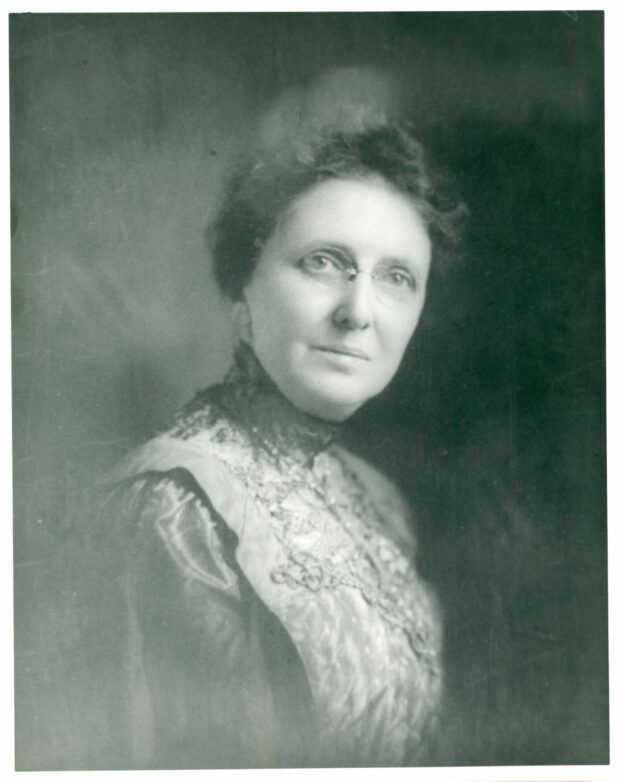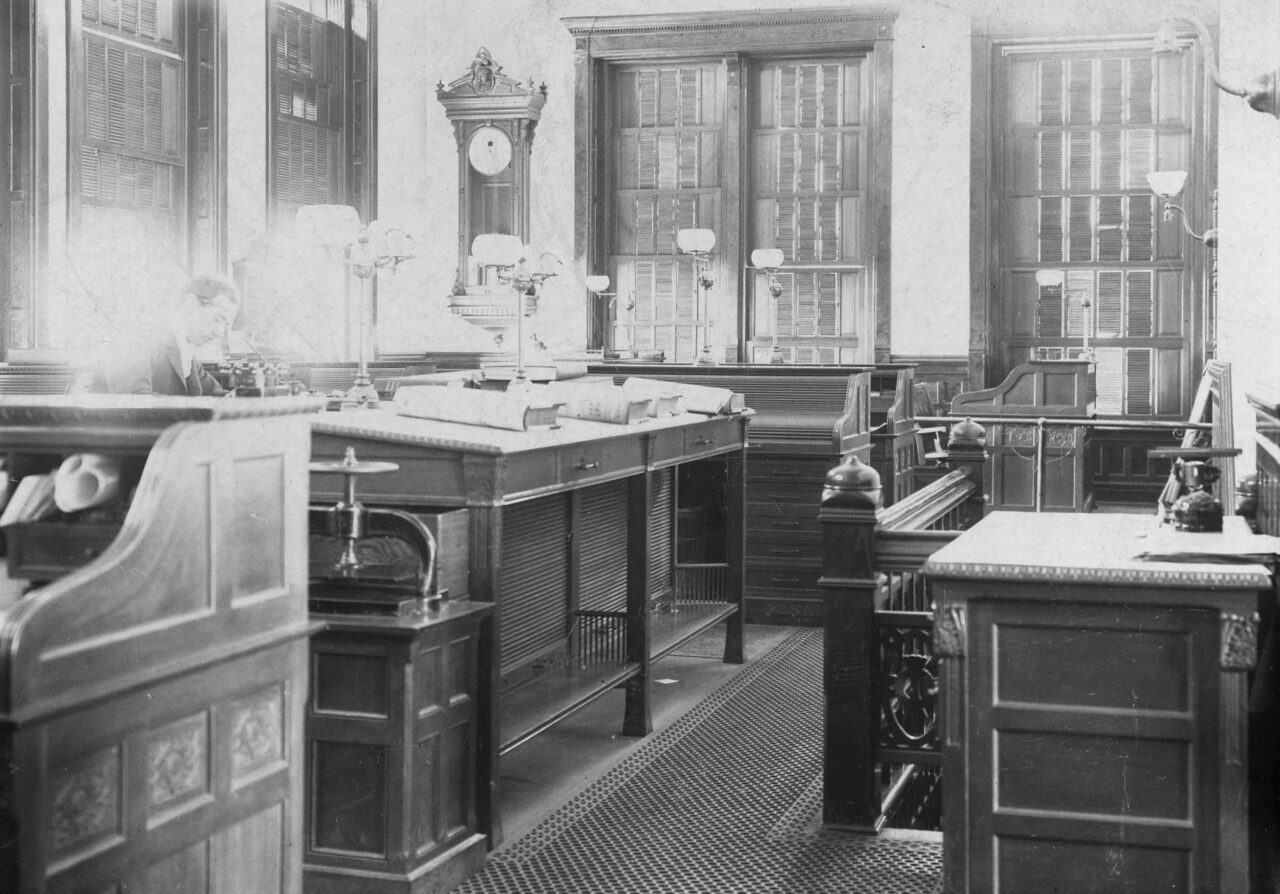The Extraordinary Life of Elizabeth Miller Watkins
Watkins Museum visitors frequently ask, “What was this building before it became a museum?”. This question often prompts a series of answers about the building’s financer, Jabez Bunting (J.B) Watkins, a self-made millionaire who constructed the building in 1888 to house two of his many businesses, the Watkins National Bank and the Watkins Land and Mortgage Company. This answer often leads visitors to the assumption that the museum is named after J.B., the mastermind behind the building and his multi-million-dollar empire. Contrary to the beliefs, the museum is really named after Elizabeth Miller Watkins, the wife of J.B. Without Elizabeth’s generosity, we can only begin to imagine where Douglas County Historical Society would be today.

Who was Elizabeth M. Watkins?
It is important to note that Elizabeth M. Watkins was more than just the wife of an extremely wealthy man. Elizabeth was a philanthropist and a steward of education and health. Publicly, she is known for her generous monetary contributions made to both the City of Lawrence and the University of Kansas. If you have ever come across a Lawrence building or organization with the name Watkins on it or in the title, there is a good chance its existence is the result of Elizabeth’s philanthropic donations.
Another notable title associated to Elizabeth is businesswoman. Around the age of 15, the unexpected death of her father forced Elizabeth to drop out of preparatory school at the University of Kansas to work and support her family. In 1875, she secured a job at the Watkins Land and Mortgage Company doing clerical work.

During her 30-year career at the Watkins Land and Mortgage Company, Elizabeth gained valuable business skills, learned the ins and outs of mortgage lending, handed the company’s public relations, and often traveled unchaperoned on business trips with her employer. Elizabeth eventually earned the position of private secretary to the company’s president and founder, J.B. Watkins. A position held predominantly by men at the time.
In 1909, Elizabeth married J.B. while on a business trip to New York City. Elizabeth was 48, and J.B. was 64. It is difficult to pinpoint exactly when their relationship moved beyond professional to romantic, but it is suspected the couple kept their relationship private for many years.

Although a large collection of business papers and correspondence belonging to J.B. and Elizabeth, their personal papers is preserved in the Kenneth Spencer Research Library at the University of Kansas, their personal papers are limited. This gap adds some mystery to Elizabeth’s life and the couple’s relationship. Why did Elizabeth and J.B marry so late in life? How did she feel about living a life that challenged the status quo of early 20th Century women? A biography that provides greater details on Elizabeth’s life is currently in the works by authors Mary Burchell and Norma Hoagland.
One personal item in the museum’s collection that belonged to Elizabeth is a scrapbook. Inside are clippings of poems, stories, and prayers from newspapers and magazines, along with a few photos of family members, and articles about her contributions and accomplishments. The curated poems and stories reflect feelings of loss, love, and the importance of dreaming big. This scrapbook offers a rare and intimate glimpse into Elizabeth’s life.

What is Elizabeth M. Watkins known for?
When J.B. died in 1921, Elizabeth inherited his estate of around $2.4 million. Assets included five Louisiana corporations, 200 Kansas Corporations, more than 200 Kansas farms, and about 100,000 acres in Texas and Louisiana. With no heir, Elizabeth devoted her remaining life and resources to philanthropic work throughout Lawrence.

From 1926 until her death in 1939, Elizabeth became a champion of health and education, which earned her the nickname, “Lady Bountiful.” Elizabeth’s motivations to support education and health presumably stem from her early life. As a young woman, she had to leave school to work and support her family. That experience motivated her to build two scholarship halls that provide financial assistance and housing to women students at KU. Her father’s occupation as a physician may have influenced her decision to support the need of hospitals and adequate medical care.
Below is a timeline of Elizabeth’s major charitable contributions in Lawrence.
| 1926 | Funded the Watkins Scholarship Hall at the University of Kansas. |
| 1928 | Funded the Lawrence Memorial Hospital. |
| 1929 | Donated the Watkins Bank Building to the City of Lawrence. |
| 1931 | Funded the Watkins Memorial Hospital at the University of Kansas (original building is now Twente Hall, home of the School of Social Welfare). |
| 1937 | Funded the Watkins Nurses Home (original building became the Hall Center for the Humanities). Funded the Miller Scholarship Hall at the University of Kansas. Funded an expansion of the Lawrence Memorial Hospital. |
| 1939 | In her last will and testimony, Elizabeth gifted the University of Kansas with several large trusts and endowments, donated farmland which doubled the size of KU and KU Medical Center in Kansas City, and donated her home “The Outlook”, now the Chancellor’s residence, to the University of Kansas. |
Why is Elizabeth M. Watkins the namesake of the Watkins Museum of History?
Elizabeth donated the Watkins Building to the City of Lawrence in 1929. The city used the building as City Hall until 1970. When they moved their offices to a new location, the property reverted to nine beneficiaries of Elizabeth’s will. In 1971, the beneficiaries transferred the building’s title to the Douglas County Historical Society (DCHS). At the time, DCHS occupied a basement room in the Police-Fire Building at 8th and Vermont and the organization was desperate for space to grow and display its collection. Thus, the Watkins Building became the perfect solution.
In 1975, DCHS opened the Elizabeth Miller Watkins Community Museum with a purpose to secure and preserve Douglas County history. Today, we know the museum as the Watkins Museum of History. Although Elizabeth’s name is no explicit in the museum’s name, her legacy lives on through the museum’s mission. As firm believer of stewardship, Elizabeth planned and managed her resources wisely to ensure her contributions would have lasting effects. Similarly, the Watkins Museum is a proud steward of the Watkins Building and the Douglas County collections. Our purpose is to preserve Douglas County heritage for future generations.
References:
Collection: J. B. Watkins papers | Kenneth Spencer Research Library Archival Collections. (n.d.). Retrieved April 13, 2022, from https://archives.lib.ku.edu/repositories/3/resources/2801
Elizabeth Miller Watkins. (n.d.). Retrieved April 12, 2022, from https://www.kitchen8.org/
Elizabeth Miller Watkins Legacy Collection, 1909? 2010—Kansas Historical Society. (n.d.). Retrieved April 12, 2022, from https://www.kshs.org/p/elizabeth-miller-watkins-legacy-collection-1909-2010/15835#biography
Elizabeth Miller Watkins photographs—Kansas Memory. (n.d.). Retrieved April 12, 2022, from https://www.kansasmemory.org/item/443493
EMW Memorial Scholarship. (n.d.). Retrieved April 12, 2022, from https://www.kitchen8.org/
KU’s “Fairy Godmother.” (2018, May 29). KU History. https://kuhistory.ku.edu/articles/kus-fairy-godmother
LAWRENCE IN PERSPECTIVE: Elizabeth Watkins | Lawrence Business Magazine. (n.d.). Retrieved April 12, 2022, from https://lawrencebusinessmagazine.com/2018/09/lawrence-in-perspective-elizabeth-watkins/